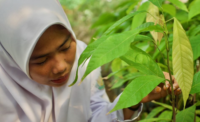The National Confectioners Association and As You Sow, a nonprofit advocating for environmental and social corporate responsibility, have released the results of a three-year effort investigating how to reduce cadmium and lead in cocoa and chocolate.
Led by a four-person, multidisciplinary committee, the investigation was funded through a California Proposition 65 settlement reached between As You Sow and 32 members of the confectionery industry in 2018. The committee includes:
- Tim Anh, senior manager of food safety, Lloyd’s Register
- Rufus L. Chaney, consultant and former senior research agronomist, USDA Agricultural Research Service
- Michael DiBartolomeis, former manager of California’s Environmental Contaminant Biomonitoring Program, the Exposure Assessment Section, the Occupational Lead Poisoning Prevention Program, the California Safe Cosmetics Program, and the Pesticide and Food Toxicology Program
- Gideon Ramtahal, research scientist, University of the West Indies
The report notes cadmium can be found in cocoa and chocolate due to its presence in soils, either through natural or man-made sources, where cocoa is cultivated and harvested in the tropics. Cocoa plants take up cadmium from soils via their roots and deposit it in the nibs of cocoa beans.
Reducing cadmium levels without compromising taste characteristics will require blending low and high cadmium beans in the short-term and changes to soil composition or cocoa genetics over time, especially in the Latin America and Caribbean regions where fine flavored cocoa is grown and cadmium levels in soils tend to be higher.
In contrast, lead is not taken up through the roots of cocoa plants. Instead, lead from many sources including soil, dust and deposition from power plants around the world, adheres to the outer shells of cocoa beans after they are extracted from the pods. The beans are naturally coated with a sticky cacao pulp, which allows lead to cling to the beans while they are being fermented and dried in the open in the tropical countries where they are grown. The investigation revealed that, where feasible, minimizing soil contact and the potential for aerial deposition at these stages of the harvesting process, and optimizing contaminant removal during subsequent bean cleaning, roasting and shell removal (as many chocolate manufacturers already do), should help reduce lead levels in finished products.
Based on its findings, the committee has identified and prioritized a list of recommended cadmium and lead reduction measures for the industry to consider implementing. Significant lead reductions can be expected within the first year of implementing new handling practices.
Cadmium reductions beyond those achieved through blending and potential changes in farming practices, including soil treatment and planting new tree stock, will take longer. Industry members plan to continue to work with As You Sow, cocoa farmers, scientists and their own quality teams to further reduce cadmium and lead levels in chocolate products as feasible.
“The research completed by this expert committee is important in revealing feasible methods of reducing both lead and cadmium in finished chocolate products,” said Danielle Fugere, president and chief counsel at As You Sow. “We appreciate the collaborative approach of the chocolate industry in funding this three-year study. It shows how California’s Toxic Enforcement Act can lead to positive change. We look forward to working with industry to set lower cadmium and lead levels as we move into the implementation phase of this work.”
Christopher Gindlesperger, NCA senior vice president of public affairs and communications, added: “NCA and its members in the chocolate industry welcome the report resulting from the expert committee investigation they funded through a prior California Proposition 65 settlement with As You Sow. We look forward to continuing to work collaboratively to implement feasible measures that assure product quality and safety so that consumers can continue to enjoy chocolate as a delicious treat.”




